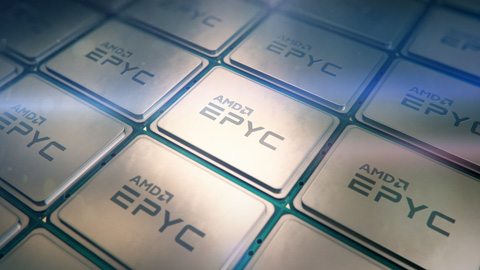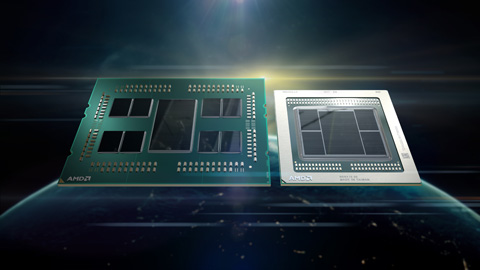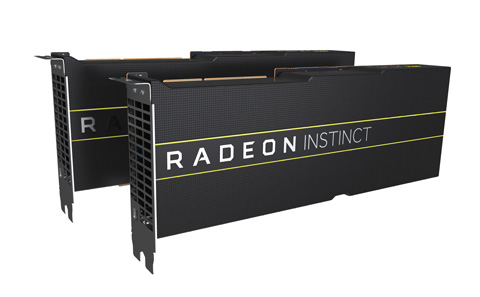
AMD has given a first glimpse of its next generation EPYC server CPU codenamed “Rome”, which features up to 64 cores and 128 threads, double that of its first generation EPYC CPU.
Powered by the “Zen 2” processor core, “Rome” uses 7nm process technology to deliver ‘much higher performance and more CPU cores at the same power.’ It will be available for one and two socket servers, giving a potential 128 cores and 256 threads in total.
The new EPYC CPU should get the attention of design and engineering firms because it promises to deliver incredible performance in multi-threaded ray trace rendering applications and simulation tools, including Computational Fluid Dynamics (CFD) software Ansys Fluent.
At the launch event in San Francisco this week, AMD demonstrated the performance gains one can expect by putting a single socket ‘Rome’ system up against competitive dual socket systems. The live demonstration featured a server with a single “Rome’ processor with 64 cores, a second server with two Intel Xeon 8180M processors, each with 28 cores, and a third server with two first generation AMD EPYC 7601 processors, each with 32 cores. Using the C-Ray ray tracing benchmark the ‘Rome’ system was 9% quicker than the Intel system and 2.5% quicker than the AMD EPYC 7601 system, despite it only using one CPU.
AMD was keen to point out that the prototype ‘Rome’ system was air cooled, ran at standard clock speeds and should deliver even better performance when the CPU officially launches in 2019.
While the emphasis is on Rome’s industry-leading 64 cores and number crunching capabilities, AMD told DEVELOP3D that it would be releasing several different models more suited to workstation virtualisation with fewer cores and higher clock speeds that are needed to run CAD and other 3D applications.
EPYC customers
AMD has been enjoying some recent customer wins with first generation EPYC. The biggest is Amazon who is now offering several AMD EPYC processor-based instances in its Elastic Compute Cloud (EC2).
AMD EPYC is also set to be used in Formula One. The Haas F1 Team will use an AMD EPYC 7000-based Cray CS500 cluster supercomputer to handle its large CFD simulations for optimizing aerodynamics and more accurately predicting and reduce drag, downforce and flow patterns around its 2019 season race cars.
64-core workstations?
“Rome” is fundamentally a server processor, designed for datacenters and well suited to clusters and render farms, but it is very likely that the ‘Zen 2’ technology on which it is based will also trickle down to the desktop.
First-generation EPYC evolved into Threadripper 2, which delivered 32 cores at high frequencies. This made it a great workstation processor for those who rely heavily on ray trace renderers like V-Ray and KeyShot and other multi-threaded applications (read our review here). If AMD does similar with EPYC 2 this can only be good news for viz-focused designers.
Intel competition
AMD was not the only firm this week to announce a new generation server CPU with lots of cores. On Monday, seemingly in an attempt to steal some of AMD’s thunder, Intel announced its forthcoming Cascade Lake Xeon CPU with 48 cores, 16 less than AMD’s ‘Rome’. Intel’s current flagship CPU is the 28 core Intel Xeon 8180M.

EPYC (left) and Vega (right) both manufactured with 7nm technology
Graphics partner
‘Rome’ also looks set to deliver some other firsts, including the first x86 server processor to support PCIe 4.0, the new generation high-speed bus standard that supports GPUs and other accelerators. With ‘double the bandwidth per channel’ PCIe 4.0 will mean data can be fed to the GPUs much quicker than before which is important when working with large datasets for GPU compute.
AMD also announced new products in this space – the ‘world’s first’ 7nm datacenter GPUs, the AMD Radeon Instinct MI60 and MI50, which are scheduled to ship this quarter.
The graphics cards are based on the “Vega” architecture and are specifically designed for machine learning, artificial intelligence (AI) and a range of HPC applications. The hardware-virtualized GPUs, which feature AMD MxGPU Technology, can also be used for workstation virtualization. AMD says this gives flexibility in how the GPUs are deployed – for example, powering virtual desktops by day and machine learning by night.
AMD claims that the AMD Radeon Instinct MI60, which has 32GB of HBM2 ECC memory, is the world’s fastest double precision PCIe 4.0 capable accelerator, delivering up to 7.4 TFLOPS peak FP64 performance. The Radeon Instinct MI50 delivers up to 6.7 TFLOPS FP64 peak performance and has 16GB of HBM2 ECC memory. Double floating-point precision is important for simulation tools including Dassault Systemes Simulia Abaqus, but not for rendering.
The new GPUs feature AMD Infinity Fabric Link GPU interconnect technology that enables GPU-to-GPU communications that are up to 6X faster than PCIe Gen 3 interconnect speeds.







